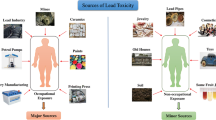Abstract
Lead poisoning is well documented in persons occupationally exposed to lead. What is less known is, that even in persons working in lead based industries, the effect of lead and the appearance of signs and symptoms of lead poisoning is genetically determined. Three genes related to lead metabolism, exhibiting polymorphism have already been demonstrated-δALA-dehydratase, Vitamin D receptor gene and Hemochromatosis gene. These alleles determine the susceptibility of the individuals to lead. We present here a case of a lead acid battery worker, who presented without any signs and symptoms of lead poisoning except for a very high level of blood lead (82.8μg/dl and 47.5μg/dl 9 months later)
Similar content being viewed by others
References
Onalja AO, Claudio L. Genetic susceptibility to lead poisoning. Environ Health Perspect 2000; 108(1): 23–28.
Roels H, Buchet JP, Lauwerys R, Hubermont G, Braux P, Thoreau FC, et al. Impact of air pollution by lead on the heme biosynthetic pathway in school-age children. Arch Environ Health 1976; 31(6):310–16.
de Kretser AJ, Waldron HA. Urinary delta amino-levulinc acid and porphobilinogen in lead-exposed workers. Brit J Ind Med 1963; 20: 35–40.
Wada O, Takeo K, Yano Y, Onu T, Nagahashi M, Seki H. d-aminolevulinic acid dehydratase in low level lead exposure. Arch Environ Health 1976; 211–4.
Millar JA, Battistini V, Cumming RLC, Carswell F, Goldberg A. Lead and d-aminolevulinic acid dehydratase levels in mentally retarded children and in lead-poisoned suckling rats. The Lancet 1970; 3: 695–8.
Hernberg S, Nikkanen J. Enzyme inhibition by lead under normal urban conditions. The Lancet 1970; 10: 63–4.
Kelada SN, Shelton E, Kaufmann RB, Khoury MJ. d-Aminolevulinic Acid Dehydratase Genotype and Lead Toxicity. Am J of Epidem 2001; 154(1): 1–13
Battistuzi G, Petrucci R, Silvagni L, et al. d-Aminolevulinic Acid Dehydratase: a new genetic polymorphism in man. Ann Hum Genet 1981; 45: 223–9.
Benkmann HG, Bogdanski P, Goedde HW. Polymorphism of delta-aminolevulinic acid dehydratase in various populations. Hum Hered 1983; 33: 62–4.
Author information
Authors and Affiliations
Rights and permissions
About this article
Cite this article
Bijoor, A.R., Venkatesh, T. Genetic susceptibility to lead poisoning—A case report. Indian J Clin Biochem 22, 162–163 (2007). https://doi.org/10.1007/BF02913338
Issue Date:
DOI: https://doi.org/10.1007/BF02913338




